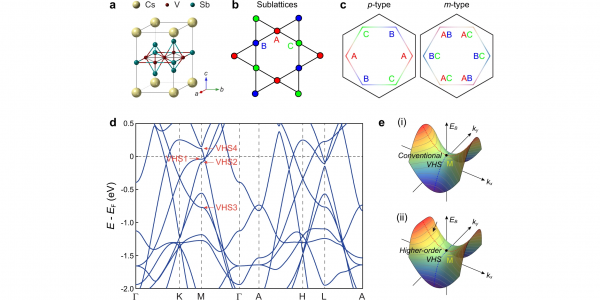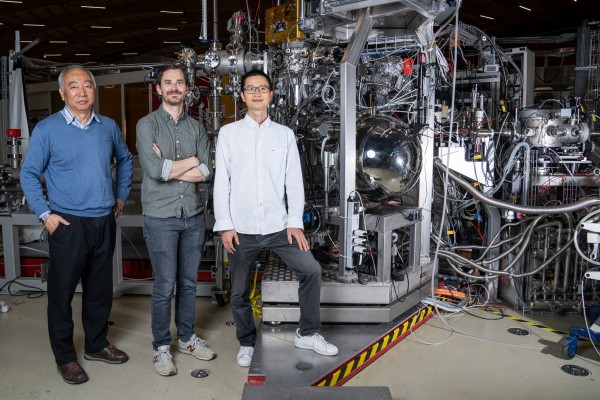Electronic structure study of AV3Sb5 kagome metals bolsters understanding of correlated phenomena
by Carey Sargent, EPFL, NCCR MARVEL
So-called kagome metals, named after the Japanese woven bamboo pattern their structure resembles, feature symmetrical patterns of interlaced, corner-sharing triangles. This unusual lattice geometry and its inherent features lead, in turn, to curious quantum phenomena such as unconventional, or high-temperature, superconductivity.
The potential for devices that might transport electricity without dissipation at room temperature—as well as a thirst for fundamental theoretical understanding—have led researchers to investigate this new class of quantum materials and try to figure out how electrons interact with the kagome lattice to generate such remarkable features.

a The Lattice structure of kagome metals CsV3Sb5. b Real space structure of the kagome vanadium planes. The red, blue, and green coloring indicate the three kagome sublattices. c Two distinct types of sublattice decorated van Hove singularities (VHSs) in CsV3Sb5, labeled as p-type (sublattice pure, left panel) and m-type (sublattice mixing, right panel). d Density functional theory calculated electronic structure of CsV3Sb5. The red arrows mark the VHSs. e Schematics of the conventional VHS (i) and higher-order VHS (ii) in two-dimensional electron systems. The gray curves in (e) indicate the constant energy contours that show markedly flat features along the ky direction in higher-order VHS, as highlighted by the black arrow.
A recently discovered class of AV3Sb5 kagome metals, where A can be =K, Rb or Cs, was shown, for instance, to feature bulk superconductivity in single crystals at a maximum Tc of 2.5 K at ambient pressure. Researchers suspect that this is a case of unconventional superconductivity, driven by some mechanism other than the phonon exchange that characterizes bonding in the electron-phonon coupled superconducting electron-pairs of conventional superconductivity.
This, as well as other exotic properties observed in the metal, are thought to be connected its multiple “Van Hove singularities” (VHSs) near the Fermi level. VHSs, associated with the density of states (DOS), or set of different states that electrons may occupy at a particular energy level, can enhance correlation effects when a material is close to or reaches this energy level. If the Fermi level lies in the vicinity of a Van Hove point, the singular DOS determines the physical behavior due to the large number of available low-energy states. In particular, interaction effects get amplified not only in the particle-particle, but also in the particle-hole channels, leading to the notion of competing orders.
Because these VHSs enhance correlation effects, it’s critically important to determine their nature and properties. This is what prompted researchers led by NCCR MARVEL scientist Professor Ming Shi, senior scientist at the Photon Science Division at the Paul Scherrer Institute, to investigate the metal further. The paper “Rich Nature of Van Hove Singularities in Kagome Superconductor CsV3Sb5,” recently published in Nature Communications, reports on their findings.

@PSI 2022 Ming Shi, Nicolas Clark Plumb, Yong Hu.
VHSs can be classified into two types, conventional and higher-order, and each is associated with distinctive features: conventional van Hove singularities involve a logarithmic singularity but higher-order VHS show a power-law divergent DOS. Moreover, VHSs in kagome lattices possess distinct features in the sublattice that lead to a reduction of the local electrostatic interactions between electric charges, effectively enhancing the role of non-local effects.
To investigate the phenomena, the researchers combined the experimental approach of polarization-dependent angle-resolved photoemission spectroscopy (ARPES) with the theoretical approach of density functional theory to directly reveal the sublattice properties of VHSs in the metal.
They identified four VHSs, three of which are close to the Fermi level. One of them, just below the Fermi level, displays an extremely flat dispersion, establishing the experimental discovery of higher-order VHS, the researchers said. This, and other features, are generalized to the AV3Sb5 family of kagome metals and have a wide range of important physical implications, detailed in the paper.
Overall, the appearance of multiple types of VHSs near the Fermi level, derived from the multi-orbital nature, can induce a rich competition for various pairing instabilities and therefore generate numerous different orders depending on small changes in the electron filling. This means that researchers may be able to access and even tune the orders in these metals through carrier doping or external pressure. Both approaches should be further investigated through experiment and theory, the researchers said.
Reference:
Hu, Y., Wu, X., Ortiz, B.R. et al. Rich nature of Van Hove singularities in Kagome superconductor CsV3Sb5. Nat Commun 13, 2220 (2022). Open access link.
Low-volume newsletters, targeted to the scientific and industrial communities.
Subscribe to our newsletter